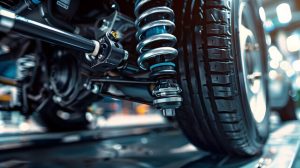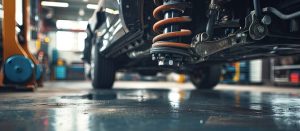The suspension system is one of the most critical aspects of a vehicle, directly influencing ride comfort, handling, safety, and overall driving experience. Different types of suspension systems offer unique characteristics that impact how a vehicle behaves on the road. Whether you’re cruising down the highway, navigating tight city streets, or tackling rough off-road terrain, the suspension plays a key role in vehicle dynamics and ride quality.
In this article, we’ll explore various suspension types, how they affect your vehicle’s performance and comfort, and what to consider when choosing or upgrading your suspension system.
Understanding Suspension Basics

The suspension system connects the vehicle’s body to its wheels, allowing for relative motion while absorbing shocks from road irregularities. It consists of several components such as springs, shock absorbers, struts, control arms, and stabilizer bars. Together, these parts manage how the vehicle responds to bumps, turns, braking, and acceleration.
Common Suspension Types and Their Characteristics
Suspension systems are broadly categorized into two main types: dependent and independent suspension. Within these, various designs exist, each with distinct advantages and drawbacks.
1. Dependent Suspension
In a dependent suspension, the wheels on the same axle are connected, so movement of one wheel affects the other. This system is simpler and often found on the rear axles of trucks and SUVs.
-
Example: Solid axle (live axle)
-
Advantages:
-
Robust and durable
-
Handles heavy loads well
-
Cost-effective and easier to maintain
-
-
Disadvantages:
-
Reduced ride comfort due to wheel interdependence
-
Less precise handling
-
Increased unsprung weight (affects responsiveness)
-
2. Independent Suspension
Each wheel moves independently from the others, allowing for better control and smoother ride quality. Independent suspension is common on modern cars and high-performance vehicles.
-
Examples:
-
Double wishbone suspension
-
MacPherson strut suspension
-
Multi-link suspension
-
| Suspension Type | Description | Ride Quality | Handling Dynamics |
|---|---|---|---|
| Double Wishbone | Uses two arms to control wheel motion precisely | Excellent | Superior control and feedback |
| MacPherson Strut | Simple, compact design with integrated spring and damper | Good | Balanced and efficient |
| Multi-link | Multiple arms allowing complex wheel motion | Very smooth | Highly adaptable and stable |
How Suspension Types Affect Ride Quality
Ride quality is primarily about how smoothly your vehicle absorbs bumps and road imperfections. Different suspension designs influence this comfort in various ways.
| Suspension Type | Ride Quality Characteristics |
|---|---|
| Dependent | Can feel harsher due to rigid axle connection; bumps on one side affect the whole axle |
| Independent | Provides a smoother ride by isolating wheel movements; better at absorbing uneven surfaces |
| Air Suspension | Uses airbags instead of springs; offers adjustable ride height and superior comfort |
| Hydropneumatic | Combines hydraulic fluid and gas for self-leveling and smooth damping |
How Suspension Types Affect Vehicle Dynamics
Vehicle dynamics refers to how the vehicle behaves during acceleration, braking, and cornering. Suspension design plays a significant role in these aspects.
-
Handling and Stability: Independent suspensions allow each wheel to react individually, enhancing grip and control during turns. Double wishbone and multi-link setups are particularly good at reducing body roll.
-
Load Carrying: Dependent suspensions with solid axles can bear heavier loads and are preferred for trucks and utility vehicles.
-
Off-road Capability: Solid axles provide durability and articulation necessary for rough terrain but compromise on-road comfort. Independent suspension offers better comfort but may limit extreme off-road articulation.
Popular Suspension Types in Detail
MacPherson Strut Suspension
-
Most common front suspension type
-
Combines shock absorber and coil spring into a single unit
-
Compact design saves space and reduces weight
-
Provides decent ride comfort and handling
-
Economical to produce and maintain
Double Wishbone Suspension
-
Uses two triangular arms (upper and lower control arms)
-
Allows precise control over wheel alignment during movement
-
Common in sports cars and luxury vehicles
-
Offers excellent handling and ride comfort but is more complex and expensive
Multi-Link Suspension
-
Consists of several arms and links controlling wheel motion in multiple directions
-
Provides excellent ride quality and handling
-
Allows tuning for specific driving characteristics
-
Found on many high-end and performance cars
Solid Axle Suspension
-
Wheels connected by a rigid axle
-
Extremely durable, suited for heavy-duty use
-
Common in rear suspensions of trucks and off-road vehicles
-
Compromises comfort and handling precision
Advantages and Disadvantages Overview
| Suspension Type | Advantages | Disadvantages |
|---|---|---|
| Dependent | Strong, simple, cost-effective | Less comfort, reduced handling precision |
| Independent | Superior comfort, better handling | More complex, potentially costlier to repair |
| Air Suspension | Adjustable, ultra-smooth ride | Expensive, requires maintenance |
| Hydropneumatic | Self-leveling, excellent damping | Complex, rare, expensive |
Suspension Selection: What to Consider?
When choosing or upgrading suspension, consider:
-
Driving Style: Sporty drivers benefit from independent or performance suspensions, while utility vehicles might prioritize load capacity.
-
Road Conditions: Rough roads may require durable suspensions like solid axles or reinforced independent systems.
-
Budget: Independent and advanced systems cost more upfront and can be pricier to maintain.
-
Vehicle Purpose: Passenger cars need comfort and handling, while trucks need durability and load support.
Maintenance and Upgrades

Proper maintenance of suspension components such as bushings, shock absorbers, springs, and control arms ensures longevity and consistent performance. When upgrading, consider performance parts tailored to your vehicle and needs.
For quality suspension parts, including sway bars, shocks, and bushings, explore options to Buy Suspension online to ensure you get compatible and reliable components.
Summary
The type of suspension system your vehicle uses significantly impacts ride quality and vehicle dynamics. Dependent suspensions offer durability and load support but compromise comfort and handling precision. Independent suspensions provide better comfort, control, and safety but come with higher complexity and cost. Advanced types like air and hydropneumatic suspensions offer the best ride quality at a premium.
Understanding these differences helps you make informed decisions about vehicle purchase, maintenance, or upgrades, enhancing your driving experience whether you prioritize comfort, performance, or utility.